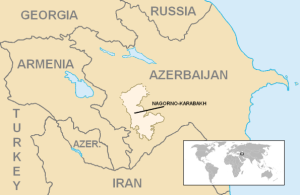Fighting in Nagorno-Karabakh Escalates to Mortar Fire
Last week, fighting in the separatist Nagorno-Karabakh region of Azerbaijan escalated to mortar shelling between Azerbaijani forces and soldiers from both Armenia and the Defense Army of the Nagorno-Karabakh Republic (NKR), leaving four NKR soldiers, three civilians, and an unknown number of Azerbaijani soldiers dead.

While border disagreements and tensions over the NKR have caused intermittent fighting between Armenia and Azerbaijan in the past, this recent clash featured the use of 82mm and 60mm mortars and rocket launchers, signaling the possibility of more serious warfare.
Nagorno-Karabakh, ethnically 95% Armenian, is considered an autonomous region within Azerbaijan and has been the cause of heavy fighting and full-scale warfare since ethinic Armenians in the region attempted to unify with Armenia in 1988. Representatives from Armenia, Azerbaijan, and Nagorno-Karabakh signed a ceasefire in 1994, but a peace agreement was never reached, and conflicts in the region continue.
Other nations and organizations view the escalation in fighting as problematic to peace and security in the region, with a European Union spokesperson describing the recent clashes as “unsustainable” and the Russian Ambassador to Armenia, Ivan Volinkin, calling the flare-up “inadmissible.” Both the EU and Russia have stressed the importance of settling the conflict through diplomacy and the Minsk Group, an organization within the Organization for Security and Co-operation in Europe dedicated to finding a peaceful resolution to the conflict.
However, a peaceful resolution seems unlikely, as President Serzh Sargsyan of Armenia recently called Nagorno-Karabakh an “inseparable part of Armenia” while Azerbaijan’s foreign minister, Elmar Mammadyarov, affirmed in a speech to the U.N. that Azerbaijan would resort to military force if Armenia refuses to withdraw its own forces from Nagorno-Karabakh.
